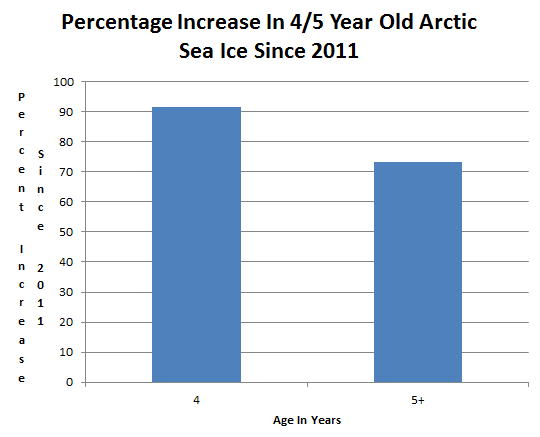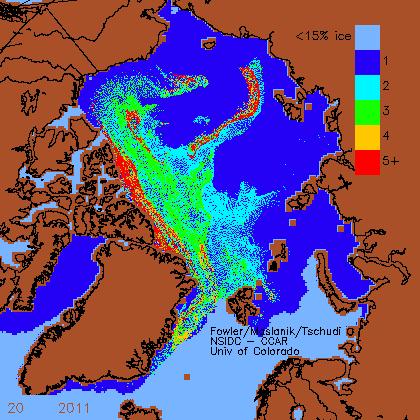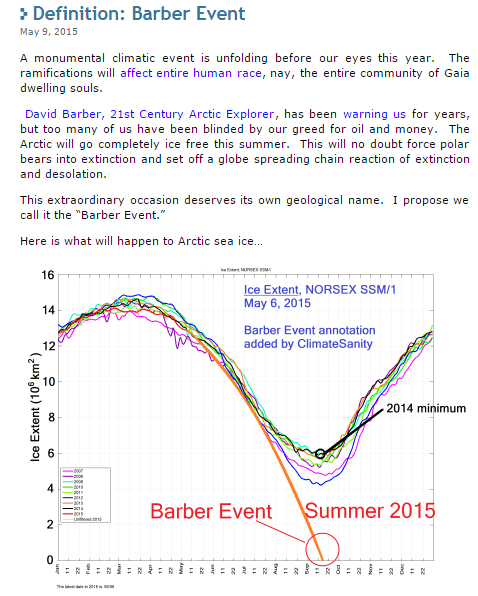A few years ago, crack government scientists announced that the Arctic was out of multi-year ice, and it was your fault
The multiyear ice covering the Arctic Ocean has effectively vanished, a startling development that will make it easier to open up polar shipping routes, an Arctic expert said on Thursday.
Vast sheets of impenetrable multiyear ice, which can reach up to 80 meters (260 feet) thick, have for centuries blocked the path of ships seeking a quick short cut through the fabled Northwest Passage from the Atlantic to the Pacific. They also ruled out the idea of sailing across the top of the world.
But David Barber, Canada’s Research Chair in Arctic System Science at the University of Manitoba, said the ice was melting at an extraordinarily fast rate.
“We are almost out of multiyear sea ice in the northern hemisphere,” he said in a presentation in Parliament. The little that remains is jammed up against Canada’s Arctic archipelago, far from potential shipping routes.
Scientists link higher Arctic temperatures and melting sea ice to the greenhouse gas emissions blamed for global warming.
Barber spoke shortly after returning from an expedition that sought — and largely failed to find — a huge multiyear ice pack that should have been in the Beaufort Sea off the Canadian coastal town of Tuktoyaktuk.
Since they made this brilliant observation, there have been huge increases in the amount of thick old ice in the Arctic.
The Beaufort Sea is full of thick multi-year ice.
Compare vs. the same date in 2011.
Being a government climate scientist means never admitting you are wrong, but rather just ramp your lies up louder.






I propose the “Barber Scenario”. 😉
It has long been known that Earth’s climate correlates with solar activity and with the number of sunspots:
http://www.john-daly.com/solar/US-drought.htm
Recent attempts to predict global climate change independent of solar activity have failed miserably:
http://www.springerlink.com/content/r2352635vv166363/
http://www.omatumr.com/abstracts2003/jfe-superfluidity.pdf
I was deeply concerned on recently learning that supporters of the seriously-flawed standard solar model (SSM) have now revised the historical sunspot record:
http://ssnworkshop.wikia.com/wiki/Home
Here is a report on recent revisions in the sunspot record.
http://www.leif.org/research/Revisiting-the-Sunspot-Number.pdf
Barber Shave?
This year, it’s more about the blob than the Barber. Bering melted out a month early, and now Chukchi is ahead of schedule. Still the BCE extent (Beaufort, Chukchi, East Siberian) is matching 2014 and even led for 2 weeks.
https://rclutz.wordpress.com/2015/07/07/arctic-ice-watch-july-7-lead-over-2014-now-4/
Last weekend when I looked it seemed the blob had moved a little south and perhaps a little east compared to where it was a month ago.
True enough. The blob is no longer directly affecting the ice. Now the issue is more open water absorbing more solar energy, and whether or not that will challenge multi-year ice in BCE, and ultimately the Arctic Sea itself.
You hurt Reggie’s feelings….
Stuff happens. Just in time for the Al Gore and Jane Fonda climate love fest in nearby Toronto. (100 km away). Could you Americans please send in the Marines and get these guys out of hear?
Tommorow’s Norfolk County weather record is a blistering 40 C set in you guessed it 1936, that period of intense unequalled global warming. Never in my 55 years in southern Ontario have I seen the temperature hit 40 C.
In 1936, Toronto had 3 straight days of 106! Saginaw in northern lower Michigan that rarely has a 95 degree day, averaged 106.5 for an entire week and got as hot as 111.
Two stations in ND hit 120!
… a huge multiyear ice pack that should have been in the Beaufort Sea off the Canadian coastal town of Tuktoyaktuk
Since Tuktoyaktuk is at the mouth of the Mackenzie River, Barber must be well aware that all that fresh water pouring into the Beaufort Sea from places further south causes the sea ice off Tuktoyaktuk to be the first place to melt in the summer!
… even Reggie knew that!
OT, but much fun..
http://www.bloomberg.com/news/articles/2015-07-08/u-k-to-scrap-climate-change-levy-exemption-osborne-says
I propose we call it a “Babar” event, because Babar was an elephant, and according to the Pinocchio Theory, each time you lie your nose gets longer.
http://media.getthefive.com/uploads/babar.jpg
It is the height of the slush season at the Pole. The DMI graph demonstrates temperatures should average at least a degree above freezing. However a large part of the Beaufort Sea was reporting below freezing temperatures, according to the most recent DMI map. (Note that a lot of these below-freezing readings are occurring below 80° latitude, and therefore not included in the DMI arctic-temperature-north-of 80°-graph, which is reporting average temperatures.)
https://sunriseswansong.files.wordpress.com/2015/07/dmi2-0708b-temp_latest-big.png
https://sunriseswansong.wordpress.com/2015/07/05/arctic-sea-ice-the-summit-of-slush-season/
Today the city nearest me set a new record high, it was the lowest ever recorded on this date.
Funny, you mentioned Babar, and that same tought ran through my head before I settled on “BS” as the most appropriate definition. I was born in France, and grew up with Babar, who interestingly married his cousin. 😉
I did hesitate to use Babar, not wanting to besmirch his good name by associating it with fraud. Also, “An elephant never forgets”, while climate scientists always forget the raw data, preferring “adjustments”, and furthermore have a hard time recalling that that the ice-free-Pole they forecast hasn’t come true.
nice observation caleb. people tend to forget ice ages are the result of shorter less warm summers , not colder winters . sea ice and cold air temperatures appear to be prevailing much further south this year than in recent times .hopefully just weather ,i have no desire to see widespread cold,which living in scotland is never too far away 🙂
I try to be more of a “witness”, and to simply observe, but there is a part of me that does “expect” certain things, which I suppose is a bit of a “forecast”.
I was actually expecting the Pacific side of the Pole to be warmer, due to both the El Nino and the warm spike of the PDO (AKA “the Blob”), and therefore the sub-freezing temperatures over the Beaufort Sea surprise me, as do the reports of a cool summer from various people in various places.
When what I expect doesn’t happen I suppose it means my unspoken forecast is “wrong”, but it really doesn’t bother me to be wrong, because I am a mere witness and not a so-called “expert”.
It really is a freedom to be unpaid, and at times I feel sorry for the absurd people who pretend to be authorities about something as unpredictable as weather and climate, and who have to justify being paid, and constantly invent excuses for being wrong.
Another indicator is from UAH NoPole TLT, which shows Apr, May, June warmer than the last two years, but much lower than 2012. UAH also shows the El Nino large warming in the tropics. Of course we have to wait to see what become the facts on the ground (or ice in this case).
Thanks for the information. I like your site, by the way.
I forgot to mention that this year there was also early melting of Barents on the Europe side, followed by Kara Sea ahead of schedule. Thus the warmer than average for the NoPole as a whole.
The melting in the Kara Sea was, I think, due to the export of a lot of ice during the winter, and the resultant thinness of the ice at the start of the melt season.
Usually you see that more over in the Laptev Sea, which didn’t export as much last winter, and has been slower to melt than last year.
The Barents Sea is still a mystery to me. I was expecting more ice due to the dip in the AMO, but even though the Atlantic has been colder towards Greenland, a memory of the warm AMO seemed to linger north of Scandinavia in Barents Sea.
The arctic is always full of surprises.
Some of those “experts” aren’t just wrong, they’re delusional and have no business being taken for any kind of authority on anything.
Some of those “experts” aren’t just wrong, they’re criminals and have no business being taken for any kind of authority on anything except fraud.
Full of thick multi-year ice…
https://earthdata.nasa.gov/labs/worldview/?p=arctic&l=MODIS_Aqua_CorrectedReflectance_TrueColor(hidden),MODIS_Terra_CorrectedReflectance_TrueColor,Reference_Labels(hidden),Reference_Features(hidden),Coastlines&t=2015-07-05&v=-2671616,-462848,-705536.0000000002,502784
You do realize that those chunks of ice which look so small in the satpic are 20-30 miles across, don’t you? Do you think they are single year ice?
So we no longer have to worry Europe will over freeze in the near future because of warming.
http://www.dailymail.co.uk/sciencetech/article-3143381/Europe-set-COLDER-Melting-sea-ice-weaken-Gulf-Stream-cause-temperatures-plummet.html?ITO=1490&ns_mchannel=rss&ns_campaign=1490